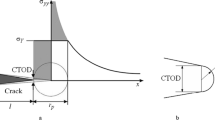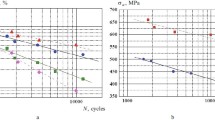Conclusions
-
1.
The calculated values of the relative difference between bending and tension-compression fatigue limits (on a base of 107 cycles) due to inelastic cyclic strains obtained for most of the materials investigated do not exceed 5% which is considerably less than the experimental values. The only exceptions are certain high-ductility austenitic and low-alloy steels.
-
2.
At stresses corresponding to endurances of 104–105 cycles a substantial (up to 40%) difference between real and nominal stresses due to inelastic strains was observed in the case of the carbon, austenitic, and low-alloy steels strained in cyclic bending; this must be taken into account in designing for strength and in constructing models of fatigue fracture of metals.
Similar content being viewed by others
Literature Cited
W. A. Weibull, “A statistical theory of strength of materials”, Proc. Roy. Swed. Inst. Eng. Research, No. 151 (1939).
N. N. Afanas'ev, Statistical Theory of the Fatigue Strength of Metals [in Russian], Izd-vo Akad. Nauk UkrSSR, Kiev (1953).
V. V. Bolotin, Statistical Methods in Building Mechanics [in Russian], Gosstroiizdat, Moscow (1961).
R. B. Heywood, Designing against Fatigue, Halsted Press (1962).
I. A. Oding, Admissible Stresses in Machine Building and Fatigue Strength of Metals [in Russian], Mashgiz, Moscow (1962).
M. Kawamoto and K. Nishioka, Memoris of the Faculty of Engineering Kyoto University,17, No. 1 (1955).
A. A. Blatherwick and B. J. Lazan, Proceedings of the American Society for Testing and Materials,56 (1956).
V. T. Troshchenko, Fatigue and Inelasticity of Metals [in Russian], Naukova Dumka, Kiev (1971).
V. T. Troshchenko and Yu. I. Koval', “A machine for investigating fatigue and inelasticity of metals under programmed loading conditions at room and elevated temperatures,” Probl. Prochnosti, No. 7 (1972).
V. T. Troshchenko and L. A. Khamaza, “Methods of investigating the dissipation of energy in metals at elevated temperatures”, Zavod. Lab., No. 8 (1970).
G. T. Ivanov and I. A. Skoryi, “Concerning the problem of approximating the deformation diagram,” in: Problems of Strength of Materials [in Russian], Proceedings of MATI, No. 37, Oborongiz (1959).
Additional information
Institute of Strength Problems, Academy of Sciences of the Ukrainian SSR, Kiev. Translated from Problemy Prochnosti, No. 4, pp. 3–9, April, 1976.
Rights and permissions
About this article
Cite this article
Troshchenko, V.T., Khamaza, L.A. Influence of inelastic strains on the fatigue limit of metals during bending. Strength Mater 8, 387–392 (1976). https://doi.org/10.1007/BF01528090
Received:
Issue Date:
DOI: https://doi.org/10.1007/BF01528090




